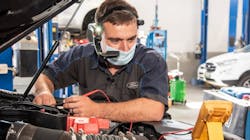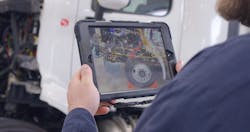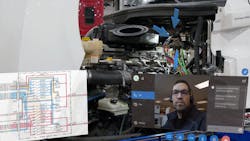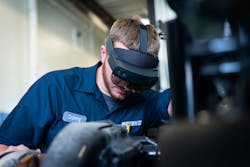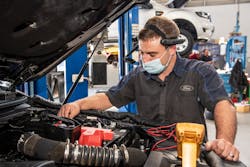AR tools continue to be adopted for vehicle maintenance
With labor hard to come by, the commercial vehicle industry is searching for solutions that can speed up repairs with the talent they have. And everyone from OEMs to fleets and dealer service shops are finding augmented reality (AR) has the potential to do just that. With AR’s capabilities to “see through” vehicles, bring in expertise and crucial documentation, expedite communication, and raise the level of proficiency, the technology has seen many use cases as of late across the industry as technicians delve into the world of 3D repair.
Here are some of the most recent and promising use cases that are speeding up real-world repair work.
Peterbilt
Peterbilt Motors recently announced that they are rolling out hundreds of augmented reality tools for technicians to use on Peterbilt chassis-specific trucks, giving them expanded visibility into repair work. Called ARTech, the proprietary tools re-conceptualize 2D technical information as full-scale 3D objects, based on CAD models, to help dealer service technicians quickly visualize major truck systems. By the end of March 2022, 200 of the AR tools will be deployed at Peterbilt dealerships.
The company stated that they worked with a team of “analysts, visionaries, designers, developers, and architects” to build ARTech, which was then tested at select Peterbilt dealerships.Peterbilt’s patented software, used in conjunction with Apple iPad tablets, also connects with existing service systems such as Paccar Solutions Service Management, and provides instant access to related technical documentation and diagrams.
The technology was first revealed at the Paccar Innovation Center in Sunnyvale, California, in 2018. Since its reveal, the company has been developing the technology to create an efficient and effective service tool.
Peyton Harrell, director of dealer network development, Peterbilt, explained to Fleet Maintenance that ARTech was fine-tuned over “hundreds of incremental updates based on technician input.”
“Peterbilt strives to have the highest level of uptime in the industry and a part of this is getting trucks back out on the road after they need service,” Harrell said. “ARTech was developed to make the service of our trucks as efficient as possible, allowing Peterbilt technicians to see, through augmented reality (essentially x-ray vision), the inner workings of our trucks before taking anything apart.
“We analyzed technicians’ pain points and focused on key technologies required to put all of the correct and pertinent data from multiple databases in one single location at their fingertips,” Harrell continued.
Leveraging a new technology for service may seem daunting, though Peterbilt’s integration with familiar platforms and devices has expedited the training and onboarding for technicians to become comfortable with ARTech.
“The technology is built around an iPad, which makes it very intuitive from the first time you pick up the device… However, Peterbilt also offers [an] extensive training program around ARTech to make sure technicians get the absolute most out of this amazing technology.
“Using ARTech provides technicians the ability to simplify a process that used to require multiple tools, while at the same time delivering the immediate knowledge of where critical electrical components exist inside a truck without removing a single panel,” Harrell explained. “A prime example is the complex wiring that is found in a modern truck. With ARTech, you get a visual representation of where all the wires are within the layout of the truck before you grab your toolbox.”
The impact has been significant.
“Dealerships who are using ARTech in their service bays have reported a 15 to 20% improvement in service repair times,” Harrell noted.
DTNA
In February, Daimler Trucks North America (DTNA) announced they had successfully piloted Microsoft’s HoloLens AR technology as a viable method of virtual collaboration with dealers and customers. DTNA is continuing to test the integration of AR into their operations.
“We really obsess over how we are adding to the value proposition we have with our business partners, the dealers, and their technicians,” said Daoud Chaaya, director, field service, DTNA. “Technicians, being the hot commodity that they are, much like truck drivers these days, it’s hard to get one in the door, and then the training scale or getting them up to speed and making sure they’re hitting the ground running is also a concern we’re trying to assist with … We want to continue to be on the cutting edge of innovation. How do we add to that value proposition? We see where we’re at right now [with] HoloLens 2.0 and how much value we can add to our technicians to speed up repairs, increase uptime.”DTNA has aligned the use of the HoloLens similarly to when a technician would contact the call center today. There is a certain “checklist” that is reviewed upfront when technicians contact the call center, with tickets filed. When a call center representative receives a call from a technician donning a HoloLens headset, the individual in the call center already has some knowledge of the technician’s situation.
“The focus is, ‘how do we minimize downtime and how do we maximize uptime?’” Chaaya said. “It’s not [achieved] through the technician teaching the call center representative what they’re seeing, so this [system of communication] allows the call center rep to come to the call prepared.”
A substantial benefit to the HoloLens system is the ability for the call center representative to bring in a subject matter expert when needed. The ability to have multiple people with “eyes” on the issue and particular expertise addressing the matter leads to clearer communication and expedited processes. Such a form of augmented collaboration offers opportunities in efficiency, accuracy, and success.
Penske Truck Leasing
As one of North America’s largest fleets, with 350,000+ vehicles, Penske Truck Leasing must also employ a huge pool of maintenance technicians, about 8,700 in all. Due to the natural attrition of the trade, Penske must train hundreds of new technicians per year, the company said, and that falls on the shoulders of 37 trainers. To increase the impact and scope of these training sessions, those instructors are now donning Microsoft HoloLens 2 devices on their heads, unlocking the power of AR and giving trainees a first-person view of a training tasks. And they reach several trainees at a time, who are watching the instructor on the XRMentor platform from a smart device or laptop.
“AR training allows us to provide very specific skill building events with a one-to-many approach,” said Holly Gerke, vice president of technical training and development, Penske Truck Leasing, to Fleet Maintenance. “We can give opportunities to technicians to sharpen their craft using a live instructor-led experience, and that's really very impactful.”The HoloLens 2 device was designed for industrial applications, and is also used at the OEM level, such as with Paccar. Oftentimes, each trainee might use a HoloLens, but Penske went in a different direction.
“We wanted to maximize that investment, so instead of putting the HoloLens in the hands of the technicians, we are putting the HoloLens on the heads of our trainers,” Gerke said.
Via customized lessons running through Design Interactive’s XRMentor (formerly AUGMENTOR) software, the trainers share their point-of-view in real time. Those are supplemented with Penske-made videos and pictures. Following the roughly 45-minute lessons, the trainees perform the same task on a pre-staged truck at their location, following specific OEM-recommended work instructions.
Video from the HoloLens 2 camera can be augmented with important information, such as technical diagrams, that are delivered to the trainee’s smart device or laptop on the XRMentor platform.
Ford
TeamViewer, a provider of remote connectivity and workplace digitalization solutions, recently announced that the Ford Motor Company is using TeamViewer’s Frontline solution to add AR “See What I See” assistance to provide enhanced support to automotive technicians across its global network of Ford dealers.
The service is offered by Ford’s Technical Assistance Center (TAC), a centralized diagnostic troubleshooting team that provides support to all Ford and Lincoln dealerships’ technicians. Dealer technicians can initially reach out to TAC specialists via a web-based portal or even on a phone. With the See What I See program, TAC specialists can start a remote AR session using TeamViewer Frontline through a pair of onsite RealWear smart glasses to share, in real time, exactly what the repair technician is looking at.
“TeamViewer Frontline supports all type of Frontline workers in their daily work routines by allowing them to access digital information, document work steps, and get remote support seamlessly while working hands-free,” said Jan Junker, EVP of Solution Delivery at TeamViewer. “In the case of the Ford TAC See What I See program, the technician at the dealership can request expert support from the Ford TAC center.
“The technician who deals with the complex problem simply needs to put on a RealWear smart glass and therefore can work together with the expert via a bidirectional audio-video-stream,” Junker explained. “The expert can see exactly the technician’s field of view and help him or her by placing virtual markers, highlight objects, or share documents, such as manuals, all in real-time while the technician is solving the problem in parallel.”Of course, training is a consideration with the use of new technologies, and TeamViewer emphasizes ease-of-use.
“We have managed to cut the necessary time for onboarding to a bare minimum and are usually able to train the technician in just five minutes,” Junker said. “The devices we deploy, especially smart glasses like RealWeare or Vuzix, are very intuitive to use and work with voice commands, mirroring the wording shown on the display, as well as a touch pad and only a few buttons. Standard procedures such as the login are all handled via QR codes, so the technician does not have to go through complex processes to establish the remote support connection. Once the call has started, the technician can be guided by the expert without further training required.”
The program has found success, as it serves to deliver clear communication and integrate critical information and expertise.
“Vehicle repair brings up a lot of challenges, such as finding the problem, and fixing it can have many complications,” Junker said. “Technicians are expected to know all the tricks for each model from the top of their head while often working against tight deadlines. Being able to request immediate remote support on a see-what-I-see basis helps to find and fix problems faster. This helps to prevent errors, decreases time needed for each repair, and improves customer satisfaction.”
In early 2020, Ford announced that technicians were to be trained how to service and maintain the Mustang Mach-E without need to access a physical model, thanks to a virtual reality (VR) training tool from Ford and Bosch.
A technician will learn how to diagnose and perform service related to the vehicle’s high-voltage system wearing the virtual reality headset. This includes tasks such as removal and installation of the main battery as well as service and maintenance on the battery pack itself.
Bosch also is developing future extensions where the technicians utilize VR to enter the vehicle and navigate through modules as if they were walking through rooms to learn the system. Navigating between modules enables the technicians to determine the issue to repair the vehicle.
This virtual reality system can be used as an ongoing training tool, allowing technicians to learn niche skills in the Ford technical training program. VR training has the potential to attract new hires to the automotive repair world, rightly framing the profession as a high-tech, forward-thinking industry in which technicians can learn more efficiently in a state-of-the-art environment. Additionally, technicians can tap into the system from any location.
Bosch developed a proof of concept in 2019 for automotive service training via virtual reality, then market tested it with instructors, technicians, and college students. Ford Motor Company is the first automaker to pilot the application in its service technician powertrain repair course, specifically with the Mustang Mach-E. Ford could expand the technology to train on additional vehicles in the future.
About the Author
Tyler Fussner
Associate Editor | Fleet Maintenance
Tyler Fussner is Managing Editor - Community Manager at Supply Chain Connect, part of the Design & Engineering Group at Endeavor Business Media.
Previously, Fussner served as the Associate Editor for Fleet Maintenance magazine. As part of Endeavor's Commercial Vehicle Group, his work has been published in FleetOwner magazine, as well as Bulk Transporter, Refrigerated Transporter, and Trailer-Body Builders.
Fussner's May 2022 print feature 'The dawn of hydrogen trucks' was named the best single technology article in B2B by the judges of the 2022 Folio: Eddie and Ozzie Awards. Fussner was also awarded Silver in the Technical Article category for the Trade Association Business Publications International (TABPI) 2021 Tabbie Awards.
Fussner previously served as Assistant Editor for Endeavor's Transportation Group on the PTEN, Professional Distributor, and VehicleServicePros.com brands.
Fussner studied professional writing and publishing at the University of Wisconsin-Whitewater. He has experience in shop operations, is a Michelin Certified Tire Technician, and a Michelin Certified Tire Salesperson.
